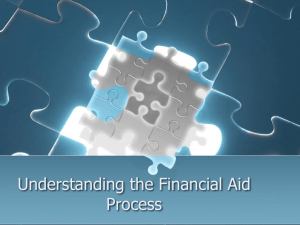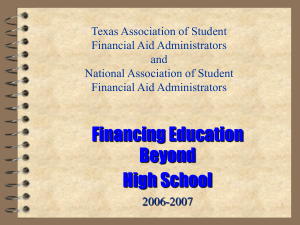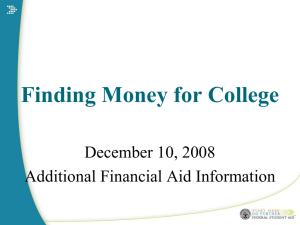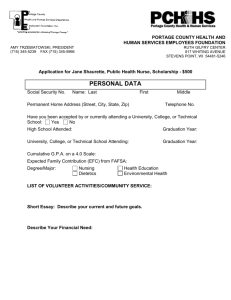2014 financial aid nigh
advertisement
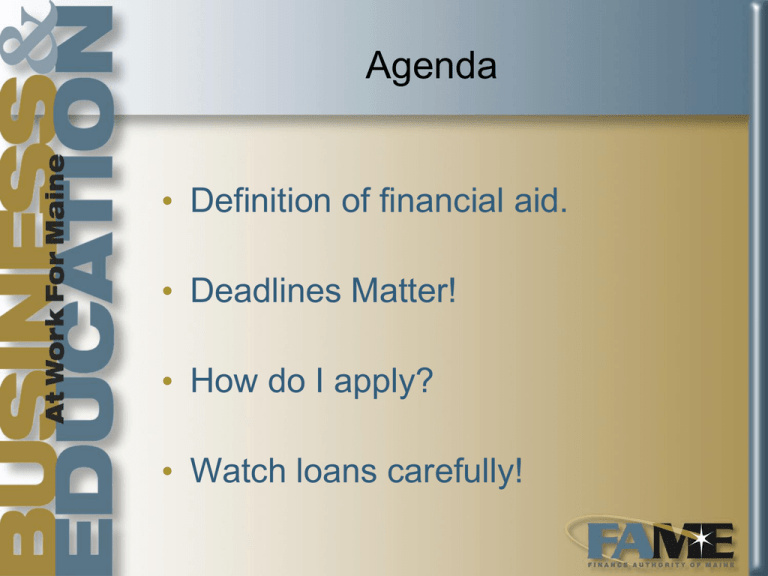
Agenda • Definition of financial aid. • Deadlines Matter! • How do I apply? • Watch loans carefully! Philosophy of Financial Aid • Students and parents are the primary source of funds for postsecondary education and are expected to pay for dependent child’s education to the extent they are able. • Students also have a responsibility to contribute to educational costs. • Financial aid is available to assist families in paying for college. Apply File on time – AND EARLY! Submit the FAFSA as soon after January 1 as possible!! • DO NOT WAIT until your taxes are filed – estimate income and update later • Accurately provide name, DOB, and social security number • Parental information – whose information is needed? • Make sure parent(s) and student each have PIN UPDATE – NEW CHANGE • For the 2015-2016 FAFSA, Parental Information has CHANGED! • If a student’s parents LIVE TOGETHER, regardless of marital status or gender, BOTH parents must provide information on FAFSA. • If unmarried, they then cannot participate in IRS Retrieval. FAFSA on the Web • Web site: www.fafsa.ed.gov • 2015-2016 FAFSA on the Web available on January 1, 2015 • FAFSA on the Web Pre-Application Worksheet: – Available prior to January 1 – Questions follow order of FAFSA on the Web FAFSA.ED.GOV • Please make sure you use the above website! NOT fafsa.com! • It is FREE to apply – if you are asked to pay, you are on the wrong page! • Make sure you apply for the 20152016 school year! FAFSA.ED.GOV • Easy Steps! • 1. Get PIN numbers • 2. Print out and complete the worksheet from FAFSA.ED.GOV • 3. Use 2013 taxes to ESTIMATE • 4. Log into FAFSA.ED.GOV and use completed worksheet to enter info • 5. Add colleges, and sign with PINs! IMPORTANT! Confirmation Page and Number OTHER FORMS • MAKE SURE YOU KNOW WHICH FORMS YOU MAY ALSO NEED! • CSS PROFILE – fee-based through Collegeboard.org • INSTITUTIONAL FORMS – check with each college Goals of Financial Aid • Primary goal is to assist students in paying for college: – Evaluate family’s ability to pay educational costs – Distribute limited resources in an equitable manner – Provide balance of gift aid and selfhelp aid ACRONYMS • FAFSA – Free Application for Federal Student Aid • EFC – Estimated Family Contribution • COA – Cost of Attendance EFC for Dependent Student Parental contribution from income and assets (Income, assets, size of household, taxes, # in college, age of eldest parent) + Student contribution from income and assets ________________________________ = Expected Family Contribution (EFC) Definition of Federal Need Cost of attendance (COA) - Expected family contribution (EFC) = Federal Need Cost of Attendance DIRECT EDUCATIONAL COSTS • Tuition • Fees, books and supplies LIVING COSTS * Room and Board * Transportation • Miscellaneous personal expenses What is Financial Aid? • Grants/Scholarships – “Free” money that does not have to be repaid. • Student Loans – Money that must be repaid. • Employment Opportunities – Money to be earned by the student. How Federal Need Varies Cost of Attendance 25,000 20,000 15,000 Need EFC 10,000 5,000 0 College A • • • • College B College C College D COA varies by school Student’s EFC the same regardless of the school Need may vary by school Financial aid may not meet the entire need Deadlines Matter!! Definition of Federal Need Cost of attendance (COA) - Expected family contribution (EFC) = Federal Need - Total Financial Aid Package ________________________________ GAP!!!!! How does GAP work? COA --------- $50,000 - EFC ------ $10,000 = Federal Need - $40,000 - Total Aid Package - $30,000 ____________________________ GAP = $10,000 so EFC now $20,000 GAP!!! • If your Financial Aid Packages does NOT cover 100% of your need, you have a GAP! MOST schools will GAP. Sources of Aid • SOURCE #1 – PARENTS/STUDENT • SOURCE #2 – Federal/State • SOURCE #3 - Institutional • SOURCE #4 - Private Institutional Aid • Grants/Scholarships – Merit Based – Need Based • Loans – Terms vary from school to school – Not all schools offer institutional loans • Employment Opportunities – Some schools offer jobs that are not federal work-study positions PAYING YOUR EFC and GAP How can you pay for your expected family contribution/GAP? • Savings & Investments (Before) • Current Income (During) • Borrowing (During and After) Financing Options • Savings – Work and save during the summer to cover expenses • Tuition Payment Plan – Make monthly payments to the college • Federal Parent PLUS Loan – Credit based, fixed interest rate • Alternative Loans – Credit based and typically require co-signer Reducing Expenses Enrollment charges • Can you save on tuition? • Transfer and AP/Dual enrollment credits • Living expenses • • • • On-campus or living at home? Meal plans Travel expenses Health insurance • Books and supplies • Buy used books, ebooks or rent them Popular Online Textbook Sites www.amazon.com www.barnesand noble.com www.chegg.com www.half.com www.textbooks.com Federal Stafford Loans • Subsidized: Must demonstrate “need” • Unsubsidized: Not based on “need” • Base annual loan limits – Undergraduates up to $5500 per year – Graduates up to $6000 per year Amount varies, dependant upon need. Other Sources of Funds • Private scholarships and – Clubs and Civic organization – Parents’ employers – Hannaford – Wal-Mart • Military – G.I. Bill – Veterans Benefits – ROTC • FAMEMAINE.COM for help, scholarship searches, etc. Final Thoughts • EVERYONE should apply for financial aid • Know and meet deadlines • Print and save copies of everything submitted • Respond quickly to requests for information • Beware solicitations charging fees • Don’t be afraid to ask questions

